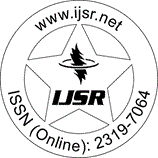Downloads: 16
India | Homeopathy | Volume 14 Issue 6, June 2025 | Pages: 31 - 33
Vital Force and Chronic Nasal Polyps: A Classical Homoeopathic Perspective
Abstract: Background: In classical homoeopathy, the concept of the vital force is fundamental to understanding the origin and progression of disease. Chronic nasal polyps (CNP), marked by persistent mucosal overgrowth in the nasal passages, often reflect a deeper constitutional imbalance. Modern treatment strategies rely heavily on surgery and corticosteroids, yet recurrence remains common. This paper explores chronic nasal polyps from a classical homoeopathic standpoint, focusing on the role of the vital force and the relevance of miasmatic theory. Objective: To interpret the clinical phenomenon of chronic nasal polyps through the lens of classical homoeopathy, with emphasis on the derangement of the vital force, miasmatic influence, and individualized remedy selection. Methodology: A narrative literature review was conducted using classical homoeopathic texts (Hahnemann's Organon, Kent's Lectures, Boenninghausen?s Therapeutic Pocketbook) along with contemporary homoeopathic and allopathic literature on nasal polyps. Theoretical analysis was performed to integrate clinical understanding with classical philosophy. Literature was included based on its relevance to CNP pathophysiology, miasmatic theory, and individualized remedy selection. Findings were synthesized to clarify the homoeopathic understanding and management of CNP. Results: The homoeopathic perspective views chronic nasal polyps as an external manifestation of internal miasmatic derangement, primarily sycotic or psoric in nature. Suppression through conventional methods may deepen the miasmatic expression. Individualized constitutional remedies?such as Teucrium marum verum, Calcarea carbonica, Lycopodium clavatum, and Thuja occidentalis?are employed to restore harmony to the vital force and bring about long-lasting relief. Conclusion: Chronic nasal polyps, when viewed through the classical homoeopathic framework, are not isolated local pathologies but expressions of a disturbed vital force. Treating the whole person through individualized, miasmatically oriented prescribing can offer a holistic, non-suppressive path to cure.
Keywords: Chronic nasal polyps, Vital force, Homoeopathy, Miasmatic theory, Constitutional remedy, Individualization
How to Cite?: Tanvi Kharbanda, Dr. Jaswinder Kaur, "Vital Force and Chronic Nasal Polyps: A Classical Homoeopathic Perspective", Volume 14 Issue 6, June 2025, International Journal of Science and Research (IJSR), Pages: 31-33, https://www.ijsr.net/getabstract.php?paperid=SR25529191543, DOI: https://dx.doi.org/10.21275/SR25529191543
